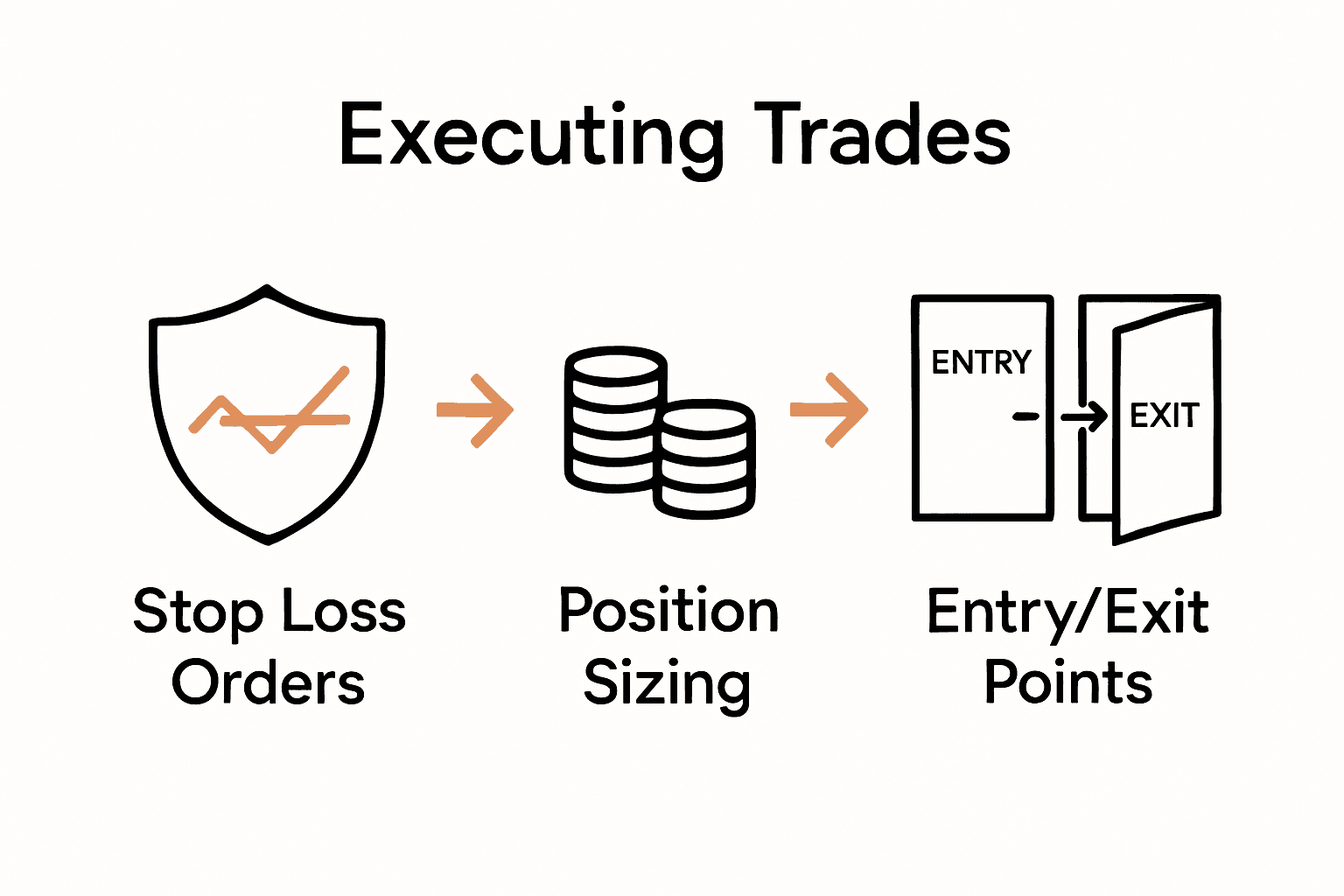Nearly 60 percent of new investors admit they feel stressed when markets swing unexpectedly. Rapid changes can shake your confidence and make decision making tricky, especially if you don’t have a clear plan. Understanding how to assess your risk tolerance, adjust your strategy, and react to volatility can keep your portfolio on track. This guide breaks down practical steps for creating a resilient investment approach that matches your personal goals and comfort level with risk.
Table of Contents
- Step 1: Assess Risk Tolerance And Financial Goals
- Step 2: Rebalance Asset Allocation Based On Conditions
- Step 3: Select Resilient Investments During Volatility
- Step 4: Execute Trades With Risk Management Tools
- Step 5: Review And Adjust Strategy Regularly
Quick Summary
| Key Point | Explanation |
|---|---|
| 1. Assess your risk tolerance | Understand your comfort with potential losses and market fluctuations to define your investment strategy. |
| 2. Regularly rebalance your portfolio | Adjust your investments periodically to maintain your desired risk level and align with your financial goals. |
| 3. Choose resilient investments | Select assets that demonstrate stability during market volatility to ensure steady portfolio performance. |
| 4. Use risk management tools | Implement stop loss orders and position sizing to protect your capital during trading. |
| 5. Review strategies consistently | Conduct regular evaluations of your portfolio to adapt to changing market conditions and align with your objectives. |
Step 1: Assess Risk Tolerance and Financial Goals
Your investing journey begins with a critical self assessment of your personal financial landscape. Understanding your unique risk tolerance and financial goals will determine the most strategic investment approach that matches your comfort level and long term objectives.
Research from ijrah.com reveals that individual investors’ personality traits significantly influence their financial risk tolerance. This means your inherent behavioral tendencies play a crucial role in how you perceive and manage investment risks. To assess your risk tolerance effectively, start by asking yourself key questions: How comfortable are you with potential investment losses? What is your emotional response when market values fluctuate?
A systematic approach involves mapping your current financial situation, future goals, and personal risk appetite. Consider creating a comprehensive financial profile that includes your age, income, existing assets, debt levels, and investment timeline. Studies from arxiv.org demonstrate that clients’ stated risk profiles often differ from their actual investment behaviors, so be honest and introspective during this assessment.
Pro Tip: Use online risk tolerance questionnaires and consult with a financial planning guide to gain objective insights into your risk profile.
By thoroughly understanding your personal financial dynamics, you can craft an investment strategy that not only matches your risk comfort zone but also aligns with your long term wealth building objectives.


Step 2: Rebalance Asset Allocation Based on Conditions
Rebalancing your investment portfolio is a strategic approach to maintaining your desired risk level and maximizing potential returns during market volatility. This process involves periodically adjusting your investment mix to align with your original financial goals and risk tolerance.
Research from arxiv.org demonstrates an innovative approach to portfolio management through deep reinforcement learning, which suggests that adaptive rebalancing can optimize risk-adjusted returns by carefully considering market conditions. The key is to develop a systematic method for reassessing your asset allocation. Start by reviewing your current portfolio composition and comparing it to your initial target allocation. Look for significant deviations that might have occurred due to market fluctuations or individual asset performance.
According to jstage.jst.go.jp, dynamic portfolio rebalancing is crucial in responding to changing market environments. When rebalancing, consider implementing a strategic approach to asset allocation that allows for measured adjustments. This typically involves selling overperforming assets and purchasing underperforming ones to maintain your original risk profile.
Pro Tip: Set a specific threshold (such as 5 or 10 percent) that triggers your rebalancing strategy, rather than making frequent unnecessary changes.
By consistently monitoring and adjusting your portfolio, you create a disciplined investment approach that helps manage risk and potentially improve long-term financial outcomes.
Step 3: Select Resilient Investments During Volatility
Choosing resilient investments during market volatility requires a strategic approach that goes beyond traditional investment selection. Your goal is to build a portfolio that can withstand market fluctuations while maintaining potential for growth and minimizing unnecessary risk.
Research from arxiv.org introduces an innovative machine learning approach called RegimeFolio, which demonstrates the importance of aligning investment decisions with current market volatility regimes. This means selecting investments that have historically demonstrated stability across different market conditions. Focus on assets with lower correlation to each other and those that have shown resilience during previous market downturns.
Additionally, emerging research from arxiv.org suggests incorporating sentiment signals from financial news can enhance portfolio performance during volatile periods. When selecting investments, consider safe investment options that provide a balance between risk and potential returns. Look for sectors and assets that tend to perform consistently across different economic environments such as utilities, consumer staples, and healthcare.
Pro Tip: Diversify your investments across multiple sectors and asset classes to reduce overall portfolio volatility.
By carefully selecting investments that demonstrate resilience and adaptability, you can build a portfolio capable of weathering market uncertainties while positioning yourself for long term financial success.
Step 4: Execute Trades With Risk Management Tools
Executing trades during market volatility requires a strategic approach that prioritizes risk management and disciplined decision making. Your primary objective is to protect your investment capital while maintaining the flexibility to capitalize on market opportunities.
Research from mdpi.com highlights an innovative framework that integrates machine learning with risk aversion adjustments for portfolio management. This approach emphasizes the critical importance of using advanced risk management tools when executing trades. Implement stop loss orders, set predetermined entry and exit points, and use position sizing techniques to limit potential losses.
Additionally, studies from jfin-swufe.springeropen.com demonstrate the effectiveness of high frequency rebalancing algorithms that incorporate volatility information. When developing your trading strategy, consider consulting a financial risk management guide to understand comprehensive risk mitigation techniques. Focus on creating a systematic approach that removes emotional decision making and relies on predetermined rules and analytics.
Pro Tip: Always allocate no more than 1 to 2 percent of your total portfolio value to any single trade to minimize potential risk exposure.
By implementing robust risk management tools and maintaining a disciplined approach, you can navigate market volatility with greater confidence and protect your investment portfolio from significant downturns.


Step 5: Review and Adjust Strategy Regularly
Regularly reviewing and adjusting your investment strategy is critical to maintaining financial resilience in a dynamic market environment. Your goal is to create a responsive approach that adapts to changing economic conditions while staying aligned with your original financial objectives.
Research from academicworks.cuny.edu highlights a sophisticated Bayesian approach to dynamic asset allocation, demonstrating the importance of periodic strategy reviews. This means conducting a comprehensive evaluation of your investment portfolio every quarter or semi annually. Analyze performance metrics, assess individual asset performance, and compare your current allocation against your initial risk tolerance and financial goals.
According to Wikipedia, cyclical tactical asset allocation suggests adjusting investment strategies based on economic cycles. When reviewing your strategy, pay close attention to broader economic indicators such as interest rates, inflation trends, and sector performance. Consider financial planning resources to help guide your review process and provide structured insights into potential strategic adjustments.
Pro Tip: Create a consistent review schedule and document your rationale for each strategic change to maintain accountability and track your decision making process.
By maintaining a disciplined approach to regular strategy review, you can proactively manage risk, capitalize on emerging opportunities, and ensure your investment portfolio remains robust and aligned with your evolving financial landscape.
Take Control of Your Investments During Market Volatility
Navigating the challenges of market ups and downs can feel overwhelming. This article highlights how understanding your risk tolerance, rebalancing your portfolio, selecting resilient investments, and using risk management tools are essential steps to protect your financial future. If you are ready to move beyond uncertainty and build a strategy tailored to your comfort level and goals, expert guidance can make all the difference.
Discover how finblog.com offers trusted resources and personalized financial planning advice to help you master investing in changing markets. Learn how to apply proven asset allocation strategies and risk management techniques by exploring our comprehensive financial planning guide and practical insights on safe investment options. Don’t wait to take informed action that safeguards your wealth and positions you for lasting results. Visit finblog.com now to start crafting your resilient investment plan with confidence.
Frequently Asked Questions
How do I assess my risk tolerance for investing during market volatility?
Understanding your risk tolerance starts with self-reflection. Evaluate your comfort level with potential losses and how you react to market fluctuations; consider completing a risk tolerance questionnaire for a clearer picture.
What steps should I take to rebalance my investment portfolio?
To rebalance effectively, review your current asset allocation against your target allocation and make adjustments. Set specific thresholds, such as 5% deviations, to trigger reevaluation and alignment with your financial goals.
What types of investments should I focus on during market volatility?
Aim to select resilient investments that have shown stability during past downturns, such as utilities or consumer staples. Diversify your portfolio by including assets that have low correlation with each other to minimize overall volatility.
How can I execute trades while managing risk in a volatile market?
Incorporate risk management tools like stop loss orders and predetermined entry and exit points. Always allocate only 1-2% of your total portfolio to any single trade to minimize potential losses.
How often should I review and adjust my investment strategy?
Aim to conduct a comprehensive review of your investment strategy every quarter or semi-annually. Assess performance metrics and align your portfolio with your original financial objectives to remain responsive to changing market conditions.










